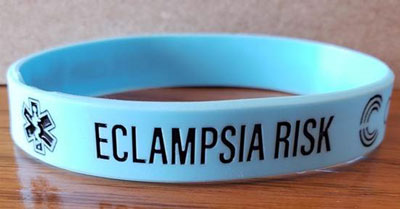Passion for Healthy Births Drives Initiative
About three years ago, I was at a national conference and saw a poster presentation on Blue Bands from a hospital in Washington. The Blue Band Initiative is an effort to improve awareness and recognition of preeclampsia. I wanted to bring the Blue Band Initiative to Central Minnesota because I care deeply about women, their health care and improving their outcomes. I also wanted to ensure women of all backgrounds get similar treatment and care. As part of the Blue Band Initiative, CentraCare now gives women at risk for preeclampsia a blue wrist band to wear during pregnancy until about six weeks after delivery to alert others of their condition.
What is Preeclampsia?
 Preeclampsia is a pregnancy complication characterized by high blood pressure and signs of damage to another organ system — most often the liver and kidneys. Preeclampsia usually begins after 20 weeks of pregnancy in women whose blood pressure had been normal.
Preeclampsia is a pregnancy complication characterized by high blood pressure and signs of damage to another organ system — most often the liver and kidneys. Preeclampsia usually begins after 20 weeks of pregnancy in women whose blood pressure had been normal.
Symptoms of preeclampsia can mimic other conditions, making it hard for first responders and medical staff to recognize, especially if patients are not obviously pregnant or unable to verbalize their medical histories. Estimates show that up to 60% of adverse outcomes from preeclampsia could have been prevented with early recognition and proper treatment.
Recognize the Symptoms
Preeclampsia sometimes develops without any symptoms. High blood pressure may develop slowly or it may have a sudden onset. Monitoring blood pressure is an important part of prenatal care because the first sign of preeclampsia is commonly a rise in blood pressure. Blood pressure that exceeds 140/90 mm Hg or greater — documented on two occasions, at least four hours apart — is abnormal.
Other signs and symptoms of preeclampsia you might see include:
- Severe headaches
- Changes in vision, including temporary loss of vision, blurred vision or light sensitivity
- Upper abdominal pain, usually under the ribs on the right side
- Nausea or vomiting
- Decreased urine output
- Shortness of breath, caused by fluid in the lungs
Sudden weight gain and swelling (edema) — particularly in the face and hands — may occur with preeclampsia. But these also occur in many normal pregnancies, so they’re not considered reliable signs of preeclampsia.
If someone you know or if you see someone who is experiencing a medical problem and who has a blue wristband, please speak up and notify medical personnel. Without proper treatment, preeclampsia can lead to stroke, seizure, organ damage or death.
My hope is that the Blue Band Initiative will extend to all other organizations throughout the state and even the Midwest. The children born now are our future, and their health, along with the health of their mothers, is of vital importance to us all.
